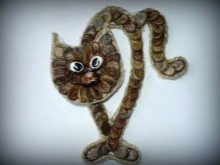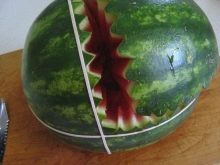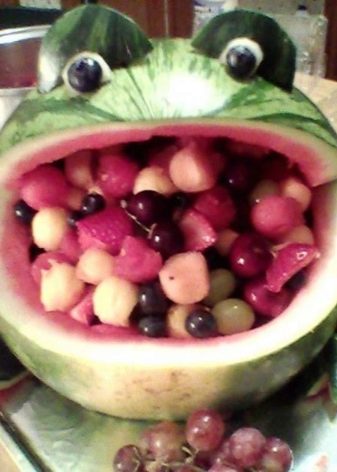Variety of watermelon crafts

Surprisingly, many fall crafts require the use of such an unusual ingredient as a watermelon. The plus is that it is possible to use not only its seeds, but also the peels themselves.



Interesting applications
To create an original autumn applique for kindergarten, watermelon seeds are ideal. The material collected in sufficient quantities is thoroughly washed under running water and transferred to a colander. When the excess liquid has drained, the seeds should be laid out on a paper towel or napkin. After drying in a natural way, all that remains is to remove the blanks in a glass container or a plastic box with a hermetically sealed lid.
It is important to remember that insufficient drying or incorrect storage contributes to the formation of mold.

To make an applique on the theme of autumn, in addition to watermelon seeds, you will need to use a sheet of cardboard or thick paper, PVA glue, and a simple pencil. The outlines of the image are drawn on the canvas. After that, the required part of the sheet is coated with glue, the seeds are tightly placed on top of it.
If it is decided to make a full-fledged panel from natural material, then it is wiser to use a board made of wood or even a sheet of plywood as a basis, and select the fixing material depending on this material.



It is quite simple to create an applique in the form of a watermelon wedge. A piece of a plant is made out on a flat base using plasticine, polymer clay or volumetric paints, and then dry seeds are fixed over the image.



Another unusual idea can be called a panel depicting a sunflower. In addition to dried seeds, creativity requires hard cardboard, double-sided tape or PVA, large berries, as well as dried leaves and yellow petals. Having cut a circle out of cardboard, it should be treated with double-sided tape or PVA glue. A rather large berry is fixed in the center, for example, mountain ash, and seeds are laid out around it by pressing tightly. The outer part of the circle is shaped with dried leaves and yellow petals.



How to make shapes?
A variety of watermelon crafts are perfect for display at school or kindergarten.
Mouse
It will be easy for small children, but it will be interesting to make small mice from watermelon seeds. At first it can be an applique: having drawn the body of an animal on the cardboard, all that remains is to glue the “pome” tail, nose, eyes and ears to it. Then you can go to the volumetric figure: a large bone is taken as a body, and ears and a tail made of plasticine are already attached to it.



Turtle
A watermelon craft in the shape of a turtle looks very interesting. To make it, the fruit is first cut lengthwise into two halves. The lower one is cleared of pulp, and its edge is decorated with any geometric pattern. A smaller cover must be cut out of the upper half and, with the help of incisions, it must be shaped under the carapace with hexagonal plates. From the remnants of the peel, legs, tail and head of the reptile are created, which are fixed on the "body" with toothpicks. After the bowl is filled with the delicious filling (fruits and berries), the turtle-shaped lid is neatly positioned on top.

Hedgehog
A beautiful craft in the shape of a hedgehog is obtained in several ways. The lightest is appliqué, which is based on a brown paper body contour. The entire surface of the workpiece, except for the head area, is filled with plasticine, and into it, in turn, watermelon bones are stuck in rows. The muzzle of the animal is complemented by plasticine eyes and a nose.



A more complex product requires the preparation of a sheet of cardboard, PVA glue, plasticine, seeds, beads, grains and dried natural materials. Thick paper is used for the clearing on which the animal will be placed. A ball rolls down from a large brown plasticine fragment, one side of which is pulled out by a cone-shaped muzzle. The hedgehog's body is covered with watermelon seeds, stuck with sharp ends up and slightly obliquely. The tip of the nose is formed by a bead, and the eyes of the animal are obtained from the seeds. The glade on which the figurine is placed is decorated with natural materials.


Finally, in the form of a hedgehog, you can simply chop the watermelon before serving it. This is done in such a way that the body is formed from the crust of the fruit, and the role of needles is played by toothpicks stuck into the previously cut pulp.

Stroller
By following the instructions step by step, you can even construct a toy stroller from watermelon peels. The process begins by removing a thin slice from the bottom of the watermelon to stabilize it. Further, the fruit is marked horizontally in the middle, as well as vertically by about 2/3. Starting from the intersection, cuts are made on the surface with a knife. The cut fragment of the fruit is temporarily set aside - the handle of the stroller will be made of it.



The pulp of the watermelon is scooped out with a special spoon-noisette to obtain balls. The handle of the craft is cut from a set aside piece of watermelon, and then fixed on the base with toothpicks or even wooden barbecue sticks. The wheels of the structure are formed from citrus fruits, and the toothpicks holding them are hidden by raspberries. The stroller is filled with balls of watermelon and melon pulp.



Ship
A ship carved from a watermelon will be a beautiful addition to the festive table. It is better to fill such a basket with diced watermelon and melon cubes, grapes, or even ice cubes.
It is more convenient to create a craft from a large fruit, even not necessarily an oblong shape.
In addition, one large and one miniature knives, a black marker, a rounded spoon for cutting balls from the pulp, a spacious container, wooden skewers and a thin string will come in handy. You can also not do without tools for cleaning vegetables and cutting out small items.

At the bottom of the fruit, a sufficient strip of rind is cut off so that the flat base gives the structure reliability. The watermelon is placed on the cut part, after which the upper edge of the ship is marked on the side along the entire circumference. In order to do this, it is necessary to step back about 2.5 cm from above and draw a horizontal line from the "bottom" to a third of the length of the fruit. Further, from the resulting point, a vertical line with a length of 3.8-5 cm is drawn down, and then another horizontal line is created from its end, about a third of the length of the fetus. At the end, the vertical line returns to the original level, and the horizontal line is drawn to the last third of the length of the watermelon. If everything is done correctly, then a small inverted letter "P" should form on the side.


Using a long knife, the watermelon is cut along the drawn contour. To make the cuts neat, the surface must be "cut", and also make sure that the opposite side of the watermelon remains intact from the inside. The whole pulp of the fruit is removed from the top and about 2/3 of the depth from the bottom.
It is more convenient to do this with a special device, but a simple spoon will do.
4 slightly curved rectangles are cut from the upper crust to become sails.


The two upper, smaller ones, are left striped, and the lower ones can be peeled off a thin green peel. A wooden skewer is pushed through the top and bottom of the parts so that two pieces of crust are passed for each. The lower ends of the resulting blanks are inserted into the bottom of the watermelon basket.


Another rectangle is cut from the remnants of the peel, and a shard with bones or some other pirate symbol is drawn on it. The resulting flag is strung horizontally on a cropped skewer so that its length exceeds the width, and is fixed at the front of the ship. It is recommended to stick another wooden skewer horizontally into the bow of the ship to obtain a bowsprit, from which a thin string will stretch to the tip of the middle mast. The side of the ship is covered with portholes: first drawn, and then partially cut out. The finished "basket" is filled with edible filling.



Frog
Similarly, a watermelon turns into a frog. First, a large "mouth" of an amphibian is cut out in the watermelon "head", which is freed from the pulp. The remaining watermelon rind is used to create the symbolic frog legs and eyelids. Small parts are fixed with toothpicks. Bright pupils are obtained from a pair of dark grapes. The resulting bowl is filled with a variety of berries and fruits.


Small house
The half of the watermelon, peeled from the pulp, in an inverted state, can act as a house. A pair of windows and doors are cut into the structure, and the remnants of the crust are used to make decorative elements - doors or benches nearby. It is not forbidden to adapt the "bottom" of the remaining half of the watermelon for the roof. The crossbars in the windows are indicated by toothpicks. It is worth placing a flashlight inside such an original toy.



Kettle
A small watermelon can be transformed into a cute teapot. To do this, the cap is cut off the fruit, and the insides are freed from the pulp. A teapot lid is cut out of the cut rind, which will cover the fruits and berries that rise above the bowl, as well as the symbolic handle and spout. The last two elements can also be made from fragments of a thin flexible hose.

DIY original gifts
Watermelon seed crafts are perfect for kids as a DIY gift.For example, for a grandparent, a child can create an autumn candlestick made from a glass beaker decorated with seeds. The box will look interesting - a tin jar with a lid, decorated with natural material, painted and varnished.



Stringing seeds on a string and alternating them with beads, you will be able to make a homemade accessory. We must not forget that delicious gifts are always perceived with a bang. So, together with their parents, the children will be able to create a beautiful basket filled with pieces of fruit, an unusual snowman with berry "bellies" or even a barrel from which a watermelon drink will pour.



From a whole watermelon it will still be possible to make a beautiful peacock.








